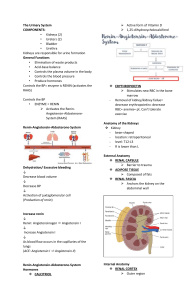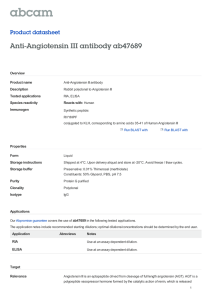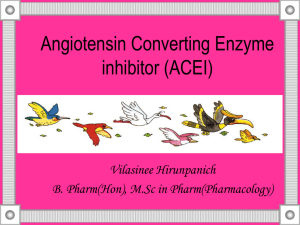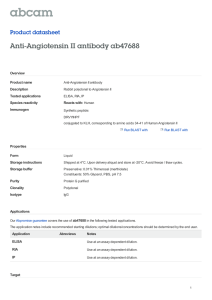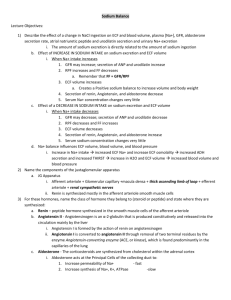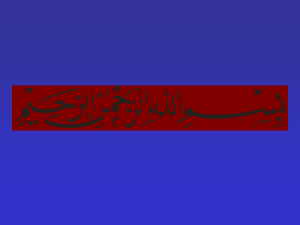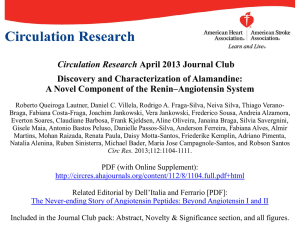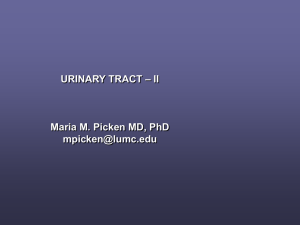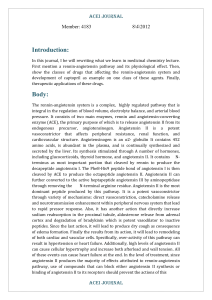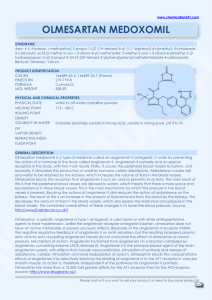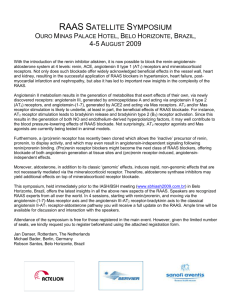Endocrine functions of the Kidneys, Heart and
advertisement
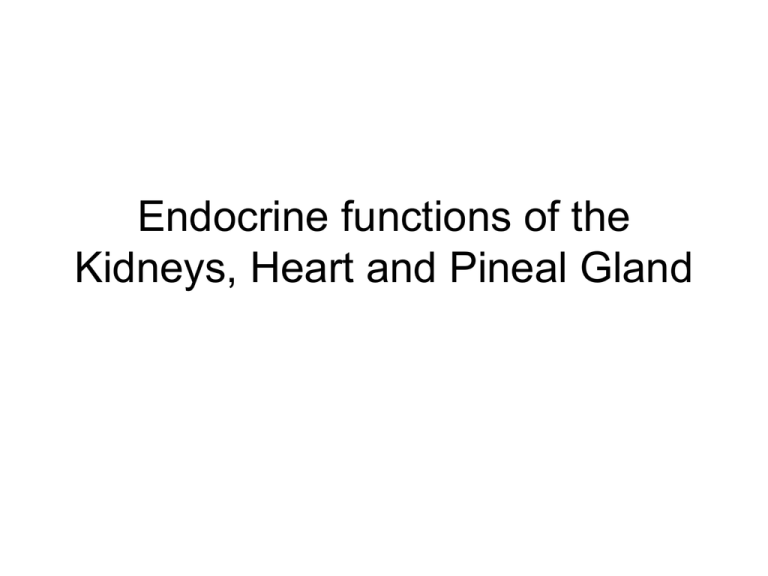
Endocrine functions of the Kidneys, Heart and Pineal Gland The kidneys produce 3 hormones. • 1,25 DHC • Renin • Erythropoietin. • The heart produces ANP although also produced by other tissues. Acts to increase excretion of Na by the kidneys. • The pineal gland secretes melatonin. Renin • Renin is an enzyme that acts together with Angiotensin converting enzyme to form angiotensin II. • Is a product primarily from the Kidneys. • Formed in the secretory granules of the JG cells. • Its only function is to split angiotensin I from angiotensinogen. Glomerulus Angiotensinogen • Found in the α globulin fraction of the plasma. • Circulating levels is increased by glucocorticoids, thyroid hormones, estrogens and angiotensin II. Angiotensin converting Enzyme • Forms angiotensin II from angiotensin I • Some conversion occurs in other parts of the body. Actions of Angiotensins • Angiotensin I functions solely as the precursor for Angiotensin II. • Angiotensin II causes arteriolar constriction and causes a rise in systolic and diastolic blood pressure. • One of the most potent vasoconstrictors known. • Acts directly on the adrenal cortex to increase aldosterone and the R-A-S system is a major regulator of aldosterone secretion. Angiotensin II • Is one of the most potent vasoconstrictors known. • Acts directly on the adrenal cortex to increase secretion of aldosterone. • Acts on the post ganglionic sympathetic neurons to release norepinephrine. • Acts on the brain to increase water intake and increase secretion of vasopressin and ACTH. The R-A-A-S Tissue R-A-S • In addition to the system generating circulating angiotensin II, many tissues contain independent R-A-S that genarate angiotensin II…for local use. • Blood vessels, uterus, placenta, eyes, exocrine portion of the pancreas, heart, adrenal cortex, testis, ovary, anterior and intermediate lobe of the pituitary . • Their function is unsettled. • Contributes very little to the circulating renin pool. The JGA • Renin is produced by the JG cells • Located in the media of the afferent arterioles as they enter the glomeruli Regulation of Renin Secretion • Increased renin secretion depends on the following: Sodium Depletion Diuretics Hypotension Hemorrhage Dehydration Heart failure cirrhosis Constriction of renal artery • Angiotensin II feeds back to inhibit renin secretion by a direct action on the JG cells. • Increased activity of the sympathetic nervous system increases renin secretion. Erythropoietin • Regulate the level of RBC in the blood by enhancing bone marrow activity. • Increased if RBCs are reduced, and reduced if the RBCs are increased. • Its blood levels are increased in anemia. • Mostly from the kidneys and some from the liver. • During fetal life, erythropoiesis takes place majorly in the liver. Liver also produces erythropoietin (15 % ) • Then erythropoiesis taken over by bone marrow, and erythropoietin produced by the kidneys. Regulation of Erythropoietin • The usual stimulus for erythropoietin secretion is hypoxia. • Also stimulated by androgens. • Secretion is also facilitated by alkalosis that develops at high altitudes also by catecholamines Hormones of the Heart and other natriuretic peptides. natriuretic peptides are secreted by the heart. • Atrial natriuretic peptide is a polypeptide • Also there is the brain natriuretic peptide • ANP and BNP act on the kidneys to increase Na excretion • Act on the renal tubules to inhibit Na reabsorption. • They relax vascular smooth muscles in arterioles and venules. • They inhibit renin secretion and counteract the pressor effect of catecholamines and angiotensin II. Pineal Gland • Known to secrete melatonin. • Functions as a timing device to regulate internal events with the light - dark cycle in the environment. • Arises from the roof of the third ventricle. • Has concretions which are radiopaque. Melatonin • No role in regulation of skin colour. • Synthesis and secretion is increased in the dark period • Low levels during the day.
